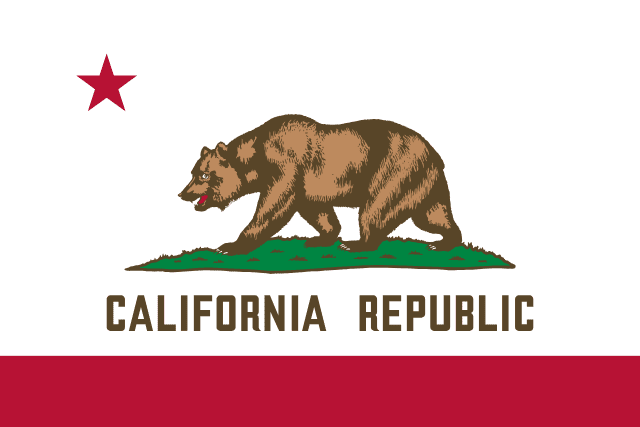State of California
Nicknames: The Golden State
Motto(s): Eureka (I have found it)
Date of Statehood: September 9, 1850 (31st state)
State Song: “I Love You, California” by F.B. Silverwood and A.F. Frankenstein
California Flag History
The flag of California, often referred to as the Bear Flag, is steeped in history and symbolism. It was first raised in 1846 by American settlers in revolt against Mexican rule during the Bear Flag Revolt. The original design, created by William Todd, featured a crude image of a grizzly bear and a star. In 1911, the California state legislature standardized the bear’s appearance and the flag’s layout.
The bear symbolizes strength and unyielding resistance, an apt representation of California’s spirit. The lone red star evokes the Lone Star of Texas, a nod to another state that fought for its independence. Beneath the star and bear, the words “California Republic” remind us of the state’s brief period as an independent republic.
The red stripe along the bottom of the flag adds a vibrant contrast to the white background and is a traditional element in many flags that symbolize courage and valor. Officially adopted on February 3, 1911, the flag’s colors of red, white, and green are a testament to the state’s diverse history, its dynamic present, and its promising future. The California flag symbolizes the state’s pioneering spirit, its natural beauty, and its status as a land of opportunity and innovation.
California Quick Facts
Capital City: Sacramento
Abbreviation: CA
Population: Approximately 39.5 million
Region: West, Pacific
Origin of State Name: Named after “Califia,” a mythical paradise in a Spanish romance written by Montalvo
Sports Teams: Notable teams include Los Angeles Lakers (NBA), San Francisco 49ers (NFL), Los Angeles Dodgers (MLB), and many more.
Bordering States: Oregon, Nevada, Arizona
Area Codes: Multiple including 213, 310, 415, 619, 714, and others
Highest Point: Mount Whitney at 14,505 feet (4,421 meters)
Lowest Point: Badwater Basin in Death Valley at -282 feet (-86 meters)
Geography of California
Area: 163,696 square miles (423,970 square kilometers), 3rd largest
Land: 155,779 square miles (403,466 square kilometers), 3rd largest
Water: 7,917 square miles (20,501 square kilometers), 6th largest
Coastline: 840 miles (1,350 kilometers), 3rd longest
Shoreline: 3,427 miles (5,515 kilometers), including bays and islands
Largest Cities:
- Los Angeles
- San Diego
- San Jose
- San Francisco
- Fresno
- Sacramento
- Long Beach
- Oakland
- Bakersfield
- Anaheim
- Santa Ana
- Riverside
- Stockton
- Chula Vista
- Irvine
National Parks:
- Channel Islands National Park
- Death Valley National Park
- Joshua Tree National Park
- Kings Canyon National Park
- Lassen Volcanic National Park
- Pinnacles National Park
- Redwood National and State Parks
- Sequoia National Park
- Yosemite National Park
California State Symbols
Living Insignia
State Bird: California Quail
State Animal: California Grizzly Bear (Officially extinct)
State Amphibian: California Red-Legged Frog
State Butterfly: California Dogface Butterfly
State Fish: California Golden Trout
State Flower: California Poppy
State Horse Breed: None
State Insect: California Dogface Butterfly
State Mammal: California Grizzly Bear (Officially extinct)
State Reptile: Desert Tortoise
Inanimate Insignia
State Fruit: Avocado
State Gemstone: Benitoite
State Soil: San Joaquin Soil
State Tree: California Redwood
State Quarter: Issued in 2005 featuring John Muir, Yosemite Valley, and California condor
State Beverage: None
State Colors: Blue and Gold
State Dance: West Coast Swing
State Food: Sourdough Bread
State Fossil: Saber-toothed Cat
State Mineral: Gold
State Rock: Serpentine

